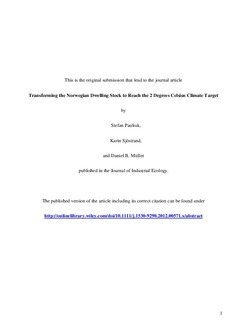| dc.contributor.author | Pauliuk, Stefan | |
| dc.contributor.author | Sjöstrand, Karin | |
| dc.contributor.author | Müller, Daniel B. | |
| dc.date.accessioned | 2013-04-11T12:39:53Z | |
| dc.date.accessioned | 2015-08-24T13:37:19Z | |
| dc.date.available | 2013-04-11T12:39:53Z | |
| dc.date.available | 2015-08-24T13:37:19Z | |
| dc.date.issued | 2013 | |
| dc.identifier.citation | Journal of Industrial Ecology 2013 | nb_NO |
| dc.identifier.issn | 1088-1980 | |
| dc.identifier.uri | http://hdl.handle.net/11250/297909 | |
| dc.description.abstract | Residential buildings account for about one third of the final energy demand in Norway. Many cost-effective measures for reducing heat losses in buildings are known and their gradual implementation may make the building sector one of the largest contributors to climate change mitigation.
To estimate the sectoral reduction potential we model a complete transformation of the dwelling stock by 2050 by both renovation and re-construction with different energy standards. We propose a new dynamic stock model with an optimization routine to identify and prioritize buildings with the highest energy saving potential. The sectoral boundary is extended by including the energy and carbon footprint of the construction industry. Despite an expected population growth of almost 50% between 2000 and 2050, sectoral carbon emissions may drop between 30 and 40% compared to emissions in 2000 for scenarios where the stock is completely transformed by either re-construction or ambitious renovation. Due to the lower upstream impact, renovation to passive house standard allows sectoral emissions to decline faster and is therefore preferable from the viewpoint of carbon emissions.
Transformation however, is not sufficient to achieve emission reduction of 50% or more as required on average to limit global warming to 2°C, because hot water generation, appliances, and lighting will dominate the sectoral footprint once the stock has been transformed. A first estimate on the impact of energy efficiency and lifestyle changes in the non-heating part of the sector reveals a maximal reduction potential of ca. 75%. | nb_NO |
| dc.language.iso | eng | nb_NO |
| dc.publisher | Wiley | nb_NO |
| dc.subject | GHG emission abatement | nb_NO |
| dc.subject | sectoral targets | nb_NO |
| dc.subject | residential buildings | nb_NO |
| dc.subject | energy efficiency | nb_NO |
| dc.subject | MFA | nb_NO |
| dc.subject | LCA | nb_NO |
| dc.subject | renovation | nb_NO |
| dc.title | Transforming the Norwegian Dwelling Stock to Reach the 2 Degrees Celsius Climate Target | nb_NO |
| dc.type | Journal article | nb_NO |
| dc.type | Peer reviewed | en_GB |
| dc.date.updated | 2013-04-11T12:39:54Z | |
| dc.source.pagenumber | 542-554 | nb_NO |
| dc.source.volume | 17 | nb_NO |
| dc.source.journal | Journal of Industrial Ecology | nb_NO |
| dc.source.issue | 4 | nb_NO |
| dc.identifier.doi | 10.1111/j.1530-9290.2012.00571.x | |
| dc.identifier.cristin | 1018063 | |
| dc.description.localcode | © 2013 by Yale University. This is the authors' accepted and refereed manuscript to the article. | nb_NO |
